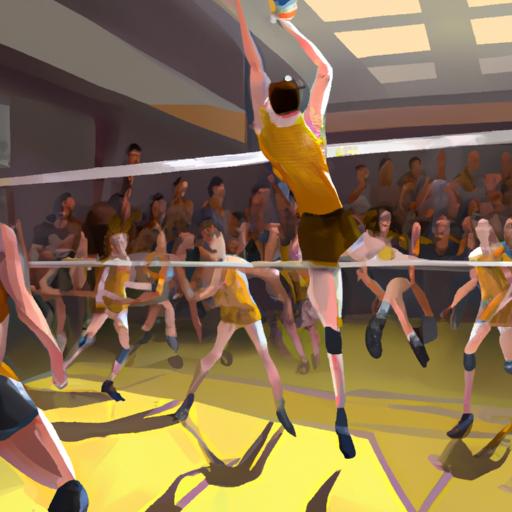Have you ever wanted to play a sport but felt that your physical disability prevented you from doing so? Sitting volleyball could be the answer to your dreams.
It is an adapted version of the classic sport of volleyball designed for people with disabilities who are unable to stand and play.
In this article, we are going to discuss the differences between sitting volleyball and traditional volleyball, including the rules, court size, and number of touches.
We will also explore the benefits of playing sitting volleyball and the different types of sitting volleyball that are available.
So if you have ever wanted to play volleyball but felt like you couldnt, read on and learn how sitting volleyball can help you achieve your goals.
Table of Contents
Short Answer
Sitting volleyball is a modified version of volleyball that is played while sitting on the ground.
It is mainly used by people with disabilities, although anyone can play.
The main difference between sitting volleyball and traditional volleyball is that the net is lower and the court is smaller.
Additionally, in sitting volleyball, players must keep one buttock on the floor at all times.
What is Sitting Volleyball?
Sitting Volleyball is a variation of the classic game of volleyball that is designed to accommodate athletes with physical disabilities.
This type of volleyball is played on a smaller court than traditional volleyball, with the net lowered to 1.15 meters for both male and female players.
The game is also played with a maximum of three touches for each team before the ball must be returned over the net.
Additionally, contact with the court is allowed to keep the ball in play, as long as it does not impede the opposing team.
Sitting Volleyball is a great way for athletes with physical disabilities to join in on the same fun and competitive spirit that traditional volleyball provides.
The game is played by sitting on the floor, hence the name, and it has the same basic rules and objectives as regular volleyball.
The main difference is that players are not allowed to jump or move from their sitting position.
This makes the game more accessible for players with physical disabilities who may not be able to jump and move like they would in a traditional volleyball game.
Another difference between the two is that Sitting Volleyball is typically played in a best-of-three sets format with each set being played to 25 points, as opposed to the traditional three sets of 15 points.
Additionally, Sitting Volleyball also has a volleyball on the floor rule which states that the ball must be returned over the net even if it is on the floor at the moment of contact.
This rule allows players to use their physical disability to keep the ball in play, as long as it does not impede the opposing team.
Overall, Sitting Volleyball is a great way for athletes with physical disabilities to join in on the same fun and competitive spirit that traditional volleyball provides.
Its a great way for those with physical disabilities to stay active and have fun with friends.
Rules of Sitting Volleyball

The rules of sitting volleyball are largely similar to those of traditional volleyball, in that two teams compete against each other to score points by grounding the ball on the opponents court.
The main difference between the two games is that in sitting volleyball, players are required to remain seated on the court at all times.
Additionally, the net is lower than in traditional volleyball (1.15 meters for both men and women), and the court is smaller.
In sitting volleyball, players are limited to three touches before the ball must be returned over the net.
Contact with the court is allowed to keep the ball in play, provided that it does not impede the opposing teams ability to play or return the ball.
It is important to note that the ball can only be hit, not thrown, over the net.
The game is won by the team that first reaches 25 points, with a minimum two-point lead.
In the event of a tie, the game continues until one team is ahead by at least two points.
Sitting volleyball is a great way for athletes with physical disabilities to enjoy the same level of competition and fun that traditional volleyball provides.
It is a great way for disabled athletes to remain active and involved in the game, while still adhering to the unique rules and regulations of the sport.
Court Size and Net Height
When it comes to the difference between sitting volleyball and regular volleyball, the first and most obvious difference is the size of the court and the height of the net.
Sitting volleyball is played on a court that is smaller than the standard court used for regular volleyball, and the net is lowered to 1.15 meters for both men and women.
This allows for easier access and movement for those with physical disabilities.
The court is also marked with two attack lines, one three meters from the center line and a second five meters from the center line.
This allows players to stay within the designated area while still being able to make plays.
The lowered net height also allows for more strategic play.
Players can use the lower net to their advantage by spiking the ball with more accuracy and precision.
This can give a team an edge when it comes to finding weaknesses in the opposing team.
The lower net also allows for more successful blocks, as the ball is not able to travel as high over the net.
The smaller court size also helps to create a more intimate setting and allows for faster-paced games.
The smaller court size means that players must move quickly to get to the ball, and that each point can be finished more quickly.
This helps to keep the game moving and can be great for athletes with physical disabilities who may not have the stamina or endurance for a full-length volleyball game.
Maximum Number of Touches

When it comes to the difference between sitting volleyball and regular volleyball, one of the most significant differences is the maximum number of touches allowed.
In regular volleyball, a team is allowed to hit the ball up to three times before returning it over the net.
In sitting volleyball, this number is limited to a maximum of three touches.
This means that the players must be more precise in their ball handling, as they have fewer opportunities to get the ball over the net.
The reduced number of touches also encourages more of a focus on passing and setting the ball, as opposed to relying on the power of an individual’s hit.
The reduction in touches also helps to make the game faster-paced, providing an exciting and engaging experience for all players.
Contact with Court Allowed
In sitting volleyball, contact with the court is allowed to keep the ball in play, as long as the contact does not impede the opposing team.
This is a feature that gives players with physical disabilities an extra edge in the game.
By allowing contact with the court, players can keep the ball in play longer and keep the game going.
It also allows them to adjust their body position and angle of attack on the ball, allowing for more dynamic and varied shots.
The rules of sitting volleyball also stipulate that players can make contact with the court up to three times before the ball must be returned over the net.
This allows players to adjust their body and the angle of their shots, as well as give them enough time to set up their next move.
This is essential for players with physical disabilities, as they may sometimes need more time to adjust and prepare for the next shot.
In addition, contact with the court is allowed for defensive play as well.
This ensures that players with physical disabilities have the same opportunities to stop the opposing team from scoring as players without disabilities.
This is especially important, as it allows players with physical disabilities to remain active and competitive in the game.
Overall, contact with the court is a helpful feature for players with physical disabilities in sitting volleyball.
It allows them to adjust their body position, angle their shots, and make defensive plays.
This gives them the opportunity to enjoy the same fun and competition that traditional volleyball provides.
Benefits of Playing Sitting Volleyball

Playing sitting volleyball has many benefits for individuals with physical disabilities.
Not only can it provide them with an opportunity to enjoy the same fun and competitive aspects of traditional volleyball, it also offers a form of physical activity and exercise that can be tailored to their specific needs and abilities.
Sitting volleyball is a great way to stay active and build strength while having fun.
Additionally, it can help to promote team building and foster relationships between individuals with physical disabilities and those without.
By participating in the game, individuals are able to gain a sense of accomplishment and build confidence in their abilities.
Lastly, playing sitting volleyball can help to create a sense of inclusion and belonging, as it is an activity that can be enjoyed by individuals of all levels of physical ability.
Different Types of Sitting Volleyball
Sitting volleyball is a modified version of the traditional volleyball game that is designed to be accessible to players with physical disabilities.
The court is smaller than a regulation-size court, and the net is lowered to 1.15 meters for both men and women.
Additionally, players are limited to a maximum of three touches before the ball must be returned over the net.
Furthermore, contact with the court is allowed to keep the ball in play, as long as the contact does not impede the opposing team.
With these changes, sitting volleyball provides athletes with physical disabilities an opportunity to experience the same fun and competition that traditional volleyball provides.
There are two types of sitting volleyball.
The first is recreational sitting volleyball, which is played in a social and non-competitive environment.
This type of sitting volleyball is ideal for beginners and those who want to enjoy the game without the pressure of competition.
The second type of sitting volleyball is competitive sitting volleyball.
This version of the game is highly competitive and is played with rules that are similar to those of traditional volleyball.
Competitive sitting volleyball is sanctioned by the International Paralympic Committee and is played by athletes with physical disabilities in national and international tournaments.
Sitting volleyball is a great way for athletes with physical disabilities to stay active and enjoy the same benefits of traditional volleyball.
It is also a great way to foster sportsmanship and camaraderie among players with disabilities.
Whether playing recreationally or competitively, sitting volleyball is a great way for athletes to have fun, stay active, and enjoy the same competitive spirit that traditional volleyball provides.
Final Thoughts
Sitting volleyball is an adapted version of the traditional volleyball game, allowing athletes with physical disabilities to enjoy the same fun and competition.
The sport has different rules than standard volleyball, including a smaller court size and net height, as well as a maximum of three touches before the ball must be returned over the net.
Additionally, contact with the court is allowed to keep the ball in play, as long as it doesn’t impede the opposing team.
With its numerous benefits, sitting volleyball is a great way to stay active and have fun.
If you or someone you know is looking for an accessible way to enjoy the sport of volleyball, give sitting volleyball a try!

